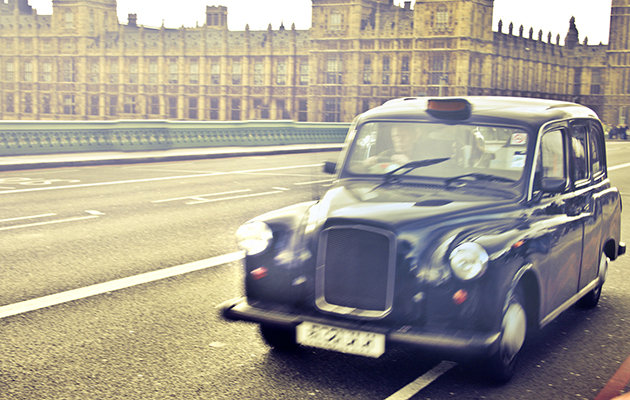
How did London’s taxis achieve universal recognition? By persistently refusing to look like anything else says Brendan Cormier
The London black cab belongs to that curious set of objects with the remarkable ability to immediately situate you in a place. Imagine yourself blindfolded and whisked away to a foreign city. With the blindfold removed, you would instinctively scan the surroundings for an overt tell; any object so completely of its terroir that you could not be anywhere else. These objects are a film director’s best friend: who needs an establishing shot of St Paul’s Cathedral when a well-framed pint glass and an overheard cockney accent works just fine? The bigger the city, the more of these signifiers you’ll find. Paris has its art nouveau ironwork grills, café chairs and book stalls. London has its telephone boxes and double-decker buses. New York has its steamy sewer grates.
It is arguable that any object that repeats itself consistently enough in a city, while at the same time being different from similar objects in other cities, is a candidate for such iconic status. Which is precisely why, in theory, a city’s taxi fleet should be a perfect contender – after all, by definition, they are meant to be everywhere. But curiously only two cities have managed to elevate their taxis to a state of universal recognition: the New York taxi, through its distinctive use of yellow; and the London black cab, through its obstinate refusal to look like anything else.
For the black cab’s aesthetic quirk, we have bureaucracy to thank. London’s Public Carriage Office, a division of the Metropolitan Police, began regulating the design of public taxis in 1906, just as the petrol engine was taking off in England. The superbly prosaic guidelines, entitled the Conditions of Fitness, set out the terms for what constituted a taxi cab in the city. It included the need for a separated passenger section, and the ability to turn on a 25ft radius – to accommodate, allegedly, the small entrance roundabout at the Savoy Hotel. Whereas other cities simply converted standard four-door production cars – whose design tended to significantly privilege drivers over passengers – into taxi fleets, the Conditions required a more bespoke design than any off-the-rack solution, predestining the black cab to be unique among its peers.
It is a great pun of history that the first brand of London cab was called Unic. In 1906, Mann & Overton, the company that supplied and financed most of London’s taxis, commissioned Unic – a French manufacturer who sold themselves on being ‘unique from the mainstream’ – to furnish the city streets with carriages that would comply with the Conditions. In 1926, in a move to protect UK manufacturing, duties were imposed on foreign imports. Mann & Overton was forced to ditch Unic, asking the Birmingham-based motor company Austin instead to convert its Heavy Twelve-Four hire car chassis to meet the city’s guidelines.
From 1930 until the end of the century, Austin cars would rule the London roads. They introduced a handful of taxi models over the following 25 years, but their reputation was sealed when the Austin FX4 debuted in 1958 and became the universal reference point for what a black cab should look like. Initially designed by the Austin draughtsman Eric Bailey, it preserved the spaciousness of its passenger side while introducing a sleek curved body and fenders. Arguably though, the FX4 was memorable simply because it survived for so long, staying in production with only minor aesthetic changes until 1997. Its longevity meant that by the end of its run, it served as a comforting historical throwback, in stark contrast to the evolved and mostly dull car design typical of the 1990s until now.
Today, the black cab is wrestling with its own identity crisis. Firstly, it is no longer really the cherished FX4. In the late 90s, Kenneth Grange was hired to design its successor, the LTI TX1, and two subsequent iterations have followed. Rather than make a radical stylistic break, the new fleet has fallen into a nostalgic trap, forced to reference the iconic FX4 while modernising it into a derivative anaemic form. Second, it is not very British anymore. The once mighty UK automotive industry underwent a series of brutal bankruptcies, buy-outs and mergers during the second half of the 20th century. Having changed hands several times, the black cab’s current manufacturer – the London Taxi Company – has now become a subsidiary of Geely, one of the rising automobile manufacturing giants of China.
Perhaps most fundamentally though, to many people the black cab is simply not very useful anymore. Too expensive and too inconvenient, younger generations have made the switch to app-based rideshares like Uber, whose anonymous fleet of whatever-the-driver-has-on-hand inconspicuously roam every corner of the city. The black cab’s days will likely soon be over, leaving behind a uniquely British legacy: a design birthed from bureaucracy, and a life of charming obstinacy against change.

















